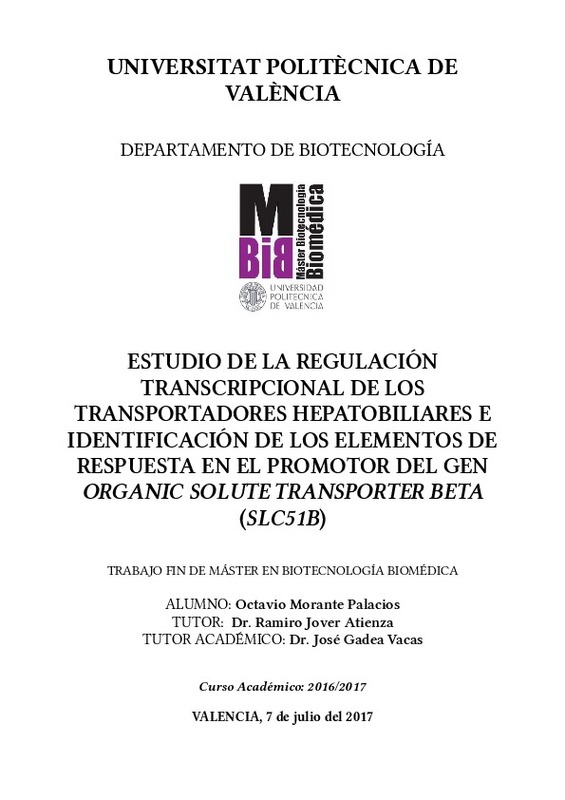|
Resumen:
|
Bile acids are amphipathic molecules produced in hepatocytes from cholesterol that act as a detergent, contributing to the hepatobiliary secretion of endogenous and xenobiotic metabolites, as well as the intestinal absorption ...[+]
Bile acids are amphipathic molecules produced in hepatocytes from cholesterol that act as a detergent, contributing to the hepatobiliary secretion of endogenous and xenobiotic metabolites, as well as the intestinal absorption of lipids, hydrophobic vitamins and drugs. In addition, they are also signaling molecules and metabolic regulators. Given the delicate biological role of bile acids, their metabolism and transport are finely regulated. Therefore, the disruption of these processes is associated with liver cholestatic diseases, fatty liver disease, dyslipidemias, diabetes, obesity and cardiovascular diseases. In the present work we focused on the regulation of transcription of a broad spectrum of human hepatobiliary canalicular transporters (BSEP, MRP2, ABCG5/ABCG8, MDR3, BCRP and MDR1) and basolateral / sinusoidal transporters (NTCP, MRP3, MRP4, OSTa/OSTb, OATP1B1, OATP1B3 and OATP1A2), by nuclear receptors and liver-enriched transcription factors: PPARa, RXRa, CAR, LXRa, PXR, FOXA1, HNF4a, C/EBPa, C/EBPb, VDR and the coactivator PGC1a. For this purpose, we have performed overexpression experiments of these factors and their combinations in HepG2, using adenoviral vectors, followed by the quantification of the level of expression of the transporters, using real-time PCR (RT-PCR). The limiting subunit (OSTb) of the heterodimeric transporter Organic solute transporter (OSTa/OSTb) is encoded by the SLC51B gene and has a fundamental function in the enterohepatic circulation since in enterocytes it is responsible for the secretion of bile acids to the portal circulation. It is also reported that it is expressed in hepatocytes where OSTb appears to play a protective role against bile acid toxicity. In cholestatic conditions, in which bile acid accumulation damage is occurring in hepatocytes, these transporters are induced as an alternative route of protection, transporting bile acids back into the blood through the basolateral membrane to allow excretion throughout the renal route. Interestingly, OSTa/OSTb is abundantly expressed in human liver, in contrast with rat or mouse liver. However, the mechanistic basis of this differential expression in human hepatocytes has not been investigated. Therefore, we have studied in greater detail the regulation of SLC51B, cloning its promoter and characterizing the binding areas of the different transcription factors, through luciferase reporter assays, with a special focus on C/EBPa and C/EBPb.
[-]
Los ácidos biliares son moléculas anfipáticas producidas en los hepatocitos a partir del colesterol que actúan como detergentes, facilitando la secreción hepatobiliar de metabolitos endógenos y xenobióticos, así como la ...[+]
Los ácidos biliares son moléculas anfipáticas producidas en los hepatocitos a partir del colesterol que actúan como detergentes, facilitando la secreción hepatobiliar de metabolitos endógenos y xenobióticos, así como la absorción intestinal de lípidos, vitaminas hidrofóbicas y fármacos. Además, también son moléculas de señalización y reguladores metabólicos. Dado el delicado rol biológico de los ácidos biliares, su metabolismo y transporte están finamente regulados. El desarreglo de estos procesos se asocia con enfermedades colestásicas hepáticas, hígado graso, dislipemias, diabetes, obesidad y enfermedades cardiovasculares.En el presente trabajo nos centramos en la regulación de la transcripción de un amplio espectro de transportadores hepatobiliares humanos, tanto basolaterales/sinusoidales (NTCP, MRP3, MRP4, OSTa/OSTb, OATP1B1, OATP1B3, OATP1A2) como canaliculares (BSEP, MRP2, ABCG5/ABCG8, MDR3, BCRP y MDR1), como por parte de factores de transcripción de relevancia en el hígado: PPARa, RXRa, CAR, LXRa, PXR, FOXA1, HNF4a, C/EBPa, C/EBPb, VDR y el coactivador PGC1a. Para ello se han realizado experimentos de sobreexpresión de dichos factores, y combinaciones de los mismos, en HepG2 mediante el uso de vectores adenovirales, seguido de la cuantificación del nivel de expresión de los transportadores, utilizando PCR en tiempo real (RT-PCR). La subunidad limitante (OSTb) del transportador heterodimérico Organic solute transporter (OSTa/OSTb) está codificada por el gen SLC51B y tiene una función fundamental en la circulación enterohepática, ya que en los enterocitos es responsable de la secreción de los ácidos biliares, absorbidos en el intestino, a la circulación portal. Asimismo, está descrito que también se expresa en los hepatocitos donde OSTb juega un papel protector frente a la toxicidad de los ácidos biliares. En condiciones colestásicas, en las cuales se está produciendo un daño por acumulación de ácidos biliares en los hepatocitos, estos transportadores se inducen como vía alternativa de protección, transportando ácidos biliares de nuevo a la sangre a través de la membrana basolateral, para permitir la excreción por vía renal. Curiosamente, la expresión de OSTa/OSTb es abundante en hígado humano pero muy escasa en hígado de rata o ratón. Sin embargo, la base mecanística de esta expresión diferencial en hepatocitos humanos no ha sido investigada. Por ello, hemos estudiado con mayor detalle la regulación de SLC51B, clonando su promotor y caracterizando las zonas del mismo en las cuales se unen los diferentes factores de transcripción mediante ensayos reporteros, con un foco especial en C/EBPa y C/EBPb.
[-]
|







